Design and Performance Analysis of the Highly Sensitive Deep Vacuum Cooling sCMOS Imaging System for Highly Sensitive Detection of Space Targets
Abstract
:1. Introduction
2. Design of HSDVCIS
2.1. Design of the Imaging Readout Processing Circuit
2.1.1. Image Sensor Selection
2.1.2. Design of FHSLTP and HSDPCC
2.2. Design of the Deep Vacuum Cooling Structure
3. Performance Tests of HSDVCIS
4. Detection Capability Analysis and Validation
4.1. Theoretical Analysis
4.2. Experimental Validation
5. Discussion
6. Conclusions
Author Contributions
Funding
Institutional Review Board Statement
Informed Consent Statement
Data Availability Statement
Acknowledgments
Conflicts of Interest
References
- ESA Space Debris Office. ESA’s Annual Space Environment Report; ESA: Darmstadt, Germany, 2022. [Google Scholar]
- Schildknecht, T. Optical surveys for space debris. Astron. Astrophys. Rev. 2007, 14, 41–111. [Google Scholar] [CrossRef] [Green Version]
- Rubenchik, A.M.; Fedoruk, M.P.; Turitsyn, S.K. The effect of self-focusing on laser space-debris cleaning. Light Sci. Appl. 2014, 3, e159. [Google Scholar] [CrossRef] [Green Version]
- Karpov, S.; Bajat, A.; Christov, A.; Prouza, M.; Beskin, G. Evaluation of scientific CMOS sensors for sky survey applications. In Proceedings of the SPIE 11454, X-ray, Optical, and Infrared Detectors for Astronomy IX, 114540G, Online Only, 14–18 December 2020; pp. 86–98. [Google Scholar] [CrossRef]
- Wu, Y.; Sharma, M.K.; Veeraraghavan, A. WISH: Wavefront imaging sensor with high resolution. Light Sci. Appl. 2019, 8, 44. [Google Scholar] [CrossRef] [PubMed] [Green Version]
- Bonanos, A.; Xilouris, M.; Boumis, P.; Bellas-Velidis, I.; Maroussis, A.; Dapergolas, A.; Fytsilis, A.; Charmandaris, V.; Tsiganis, K.; Tsinganos, K. NELIOTA: ESA’s new NEO lunar impact monitoring project with the 1.2 m telescope at the National Observatory of Athens. Proc. Int. Astron. Union 2015, 10, 327–329. [Google Scholar] [CrossRef]
- Xilouris, E.M.; Bonanos, A.Z.; Bellas-Velidis, I.; Boumis, P.; Dapergolas, A.; Maroussis, A.; Liakos, A.; Alikakos, I.; Charmandaris, V.; Dimou, G.; et al. NELIOTA: The wide-field, high-cadence, lunar monitoring system at the prime focus of the Kryoneri telescope. Astron. Astrophys. 2018, 619, A141. [Google Scholar] [CrossRef] [Green Version]
- Ploner, M.; Lauber, P.; Prohaska, M.; Schlatter, P.; Utzinger, J.; Schildknecht, T.; Jäggi, A. The new CMOS Tracking Camera used at the Zimmerwald Observatory. In Proceedings of the 18th International Workshop on Laser Ranging, Fujiyoshida, Japan, 11–15 November 2013. [Google Scholar]
- Silha, J.; Linder, E.; Hager, M.; Schildknecht, T. Optical light curve observations to determine attitude states of space debris. In Proceedings of the 30th International Symposium on Space Technology and Science, Kobe-Hyogo, Japan, 3–9 June 2015. [Google Scholar]
- Nir, G.; Ofek, E.O.; Ben-Ami, S.; Manulis, I.; Gal-Yam, A.; Diner, O.; Rappaport, M. Weizmann Fast Astronomical Survey Telescope (WFAST). In Proceedings of the American Astronomical Society Meeting Abstracts# 229, Grapevine, TX, USA, 3–7 January 2017. id. 155.06. [Google Scholar]
- Nir, G.; Ofek, E.O.; Ben-Ami, S.; Segev, N.; Polishook, D.; Hershko, O.; Diner, O.; Manulis, I.; Zackay, B.; Gal-Yam, A.; et al. The Weizmann Fast Astronomical Survey Telescope (W-FAST): System Overview. Publ. Astron. Soc. Pac. 2021, 133, 075002. [Google Scholar] [CrossRef]
- Polkowska, M.; Chimicz, A. Status of SSA activities in Poland and recent SST developments. J. Space Saf. Eng. 2022, 9, 629–635. [Google Scholar] [CrossRef]
- Rogowska, B.; Konacki, M.; Chimicz, A.; Pawłaszek, R.; Kozłowski, S.; Sybilski, P.; Zwyciestwa, A. Panoptes-1AB and Solaris-5 unique wide field telescopes with sCMOS cameras. In Proceedings of the Advanced Maui Optical and Space Surveillance Technologies Conference, Maui, HI, USA, 17–20 September 2019; p. 75. [Google Scholar]
- Farrell, J.; Xiao, F.; Kavusi, S. Resolution and light sensitivity tradeoff with pixel size. In Proceedings of the SPIE 6069, Digital Photography II, 60690N, San Jose, CA, USA, 15–19 January 2006; pp. 211–218. [Google Scholar] [CrossRef]
- Minoglou, K.; Nelms, N.; Ciapponi, A.; Weber, H.; Wittig, S.; Leone, B.; Crouzet, P. Infrared image sensor developments supported by the European Space Agency. Infrared Phys. Technol. 2019, 96, 351–360. [Google Scholar] [CrossRef]
- Gill, A.S.; Shaaban, M.M.; Tohuvavohu, A.; Sivanandam, S.; Abraham, R.G.; Chen, S.; Drout, M.R.; Lokhorst, D.; Matzner, C.D.; Mochnacki, S.W. A low-cost ultraviolet-to-infrared absolute quantum efficiency characterization system of detectors. In Proceedings of the SPIE 12191, X-ray, Optical, and Infrared Detectors for Astronomy X, 1219114, Montréal, QC, Canada, 17–23 July 2022; pp. 374–388. [Google Scholar] [CrossRef]
- Ma, K.; Shi, Z.; Wang, H.; Zou, J.; Wang, W. A research on non-uniformity index of star sensor based on CMOS. In Proceedings of the SPIE 11763, Seventh Symposium on Novel Photoelectronic Detection Technology and Applications, 1176387, Kunming, China, 5–7 November 2020; pp. 2165–2171. [Google Scholar] [CrossRef]
- Yao, P.; Zhu, B.; Li, C.; Wang, H.; Dai, H.; Yang, Y. Design of solar observation electronics system for space application. In Proceedings of the SPIE 12069, AOPC 2021: Novel Technologies and Instruments for Astronomical Multi-Band Observations, 120690T, Beijing, China, 23–25 July 2021; pp. 184–189. [Google Scholar] [CrossRef]
- Huang, Z.-g.; Xu, Y.-l.; Wang, J.-m.; Zhang, Y.; Chen, C.; Zhang, H.-f.; Wang, J. Thermodynamics simulation for vacuum head of a 1K x 1K CCD camera. In Proceedings of the SPIE 10709, High Energy, Optical, and Infrared Detectors for Astronomy VIII, 107092J, Austin, TX, USA, 10–15 June 2018; pp. 626–631. [Google Scholar] [CrossRef]
- He, J.; Tritt, T.M. Advances in thermoelectric materials research: Looking back and moving forward. Science 2017, 357, eaak9997. [Google Scholar] [CrossRef] [PubMed] [Green Version]
- Pan, C.; Youshan, Q.; Huijuan, L.; Jiahai, T. Design and implementation of cooling system for focal plane assembly of observation camera in astronomical satellite. In Proceedings of the 2011 International Conference on Electronics, Communications and Control (ICECC), Ningbo, China, 9–11 September 2011; pp. 2615–2619. [Google Scholar]
- Yu, Y.; Zhu, W.; Kong, X.; Wang, Y.; Zhu, P.; Deng, Y. Recent development and application of thin-film thermoelectric cooler. Front. Chem. Sci. Eng. 2020, 14, 492–503. [Google Scholar] [CrossRef]
- EMVA 1288; Standard for Characterization of Image Sensors and Cameras. European Machine Vision Association: Barcelona, Spain, 2016; Release 3.1.
- Torralba, O.R.; Jehn, R.; Koschny, D.; Frühauf, M.; Jehn, L.S.; Praus, A. Simulation of Sky Surveys with the Flyeye telescope. arXiv 2019, arXiv:1903.08413. [Google Scholar]
- Zombeck, M.V. Handbook of Space Astronomy and Astrophysics; Cambridge University Press: Cambridge, UK, 2006. [Google Scholar]
- Jin, X.; Hirakawa, K. Approximations to camera sensor noise. In Proceedings of the SPIE 8655, Image Processing: Algorithms and Systems XI, 86550H, Burlingame, CA, USA, 3–7 February 2013; pp. 149–155. [Google Scholar] [CrossRef]
- Pan, Y.; Fan, X.; Wang, H.; Zhao, H.; Qiu, Y.; Gao, W.; Zhang, J. Accurate Determination of Conversion Gains of SVOM VT CCDs Based on a Signal-Dependent Charge-Sharing Mechanism. Electronics 2021, 10, 931. [Google Scholar] [CrossRef]
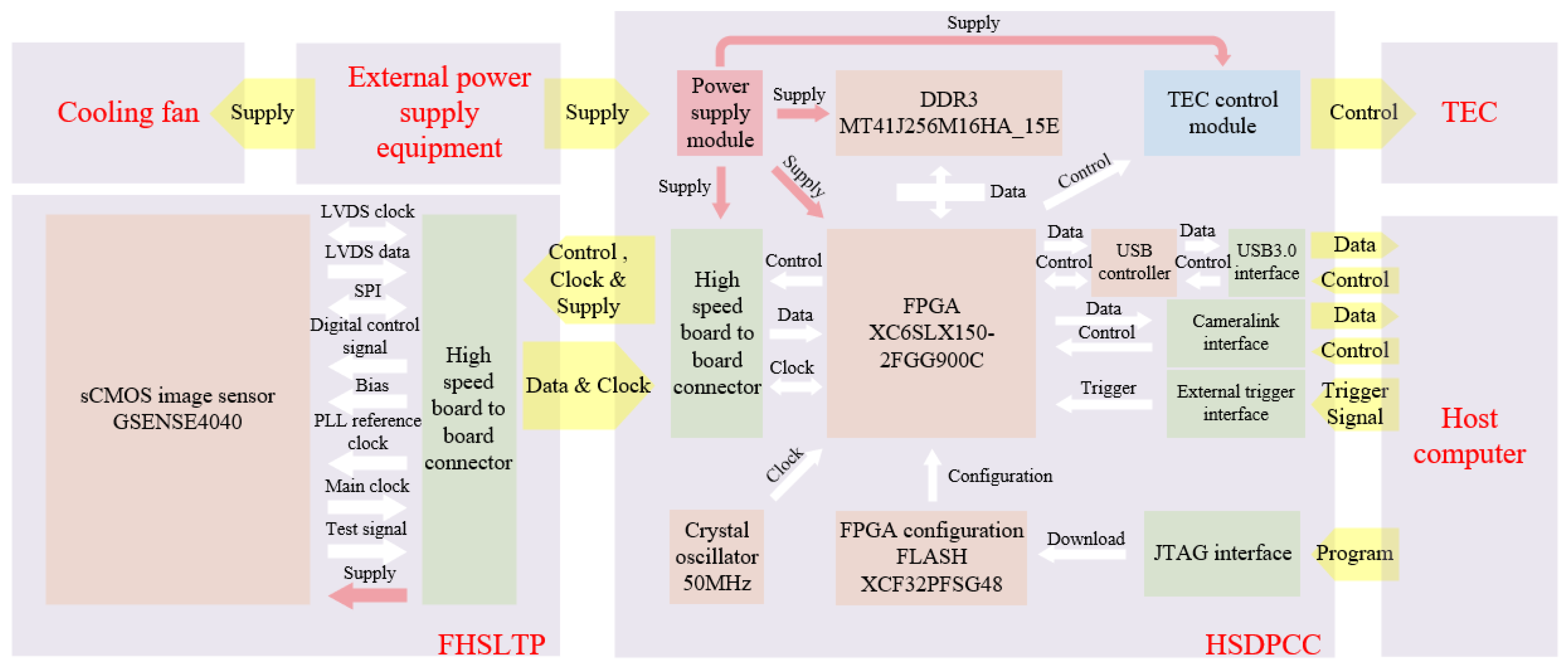
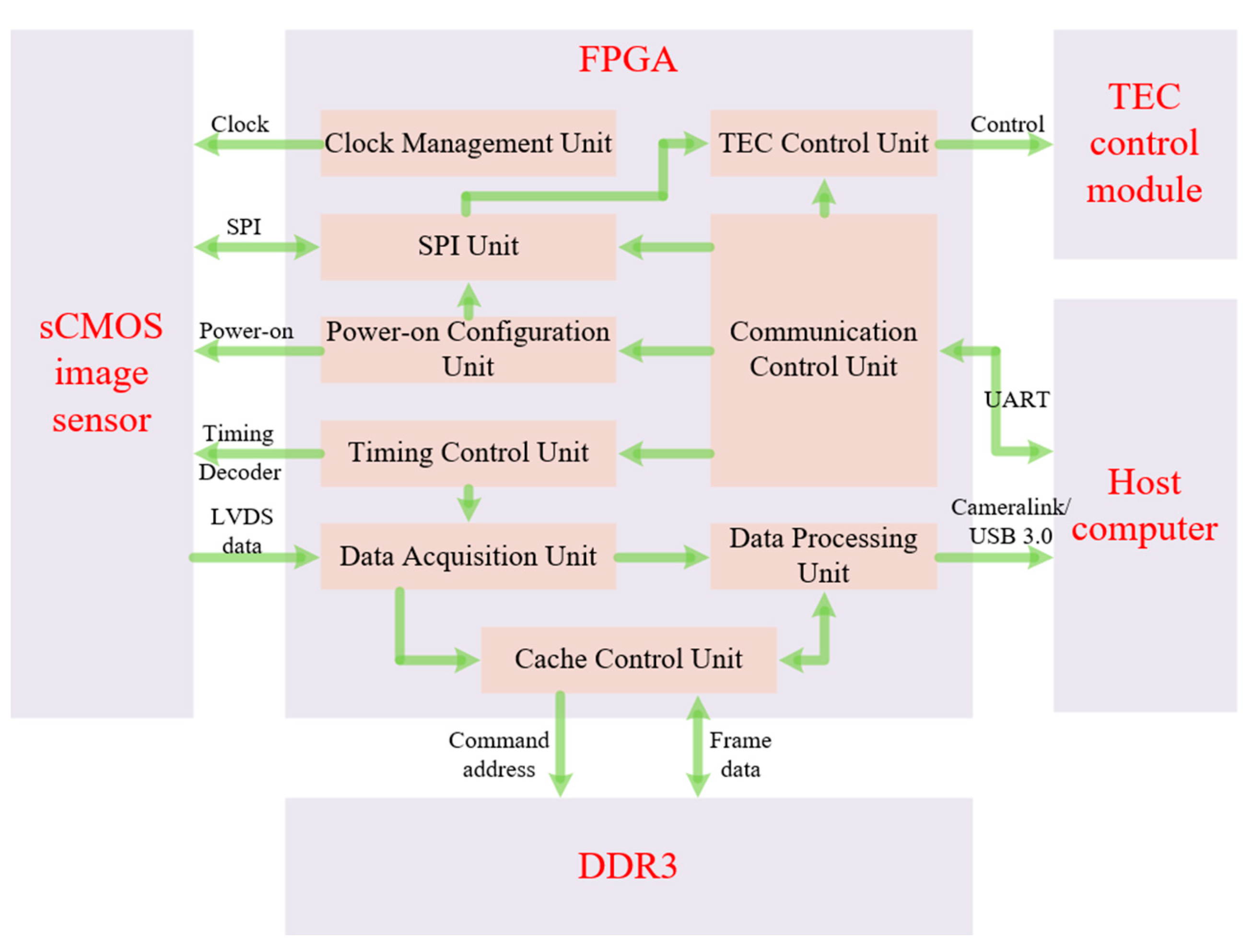

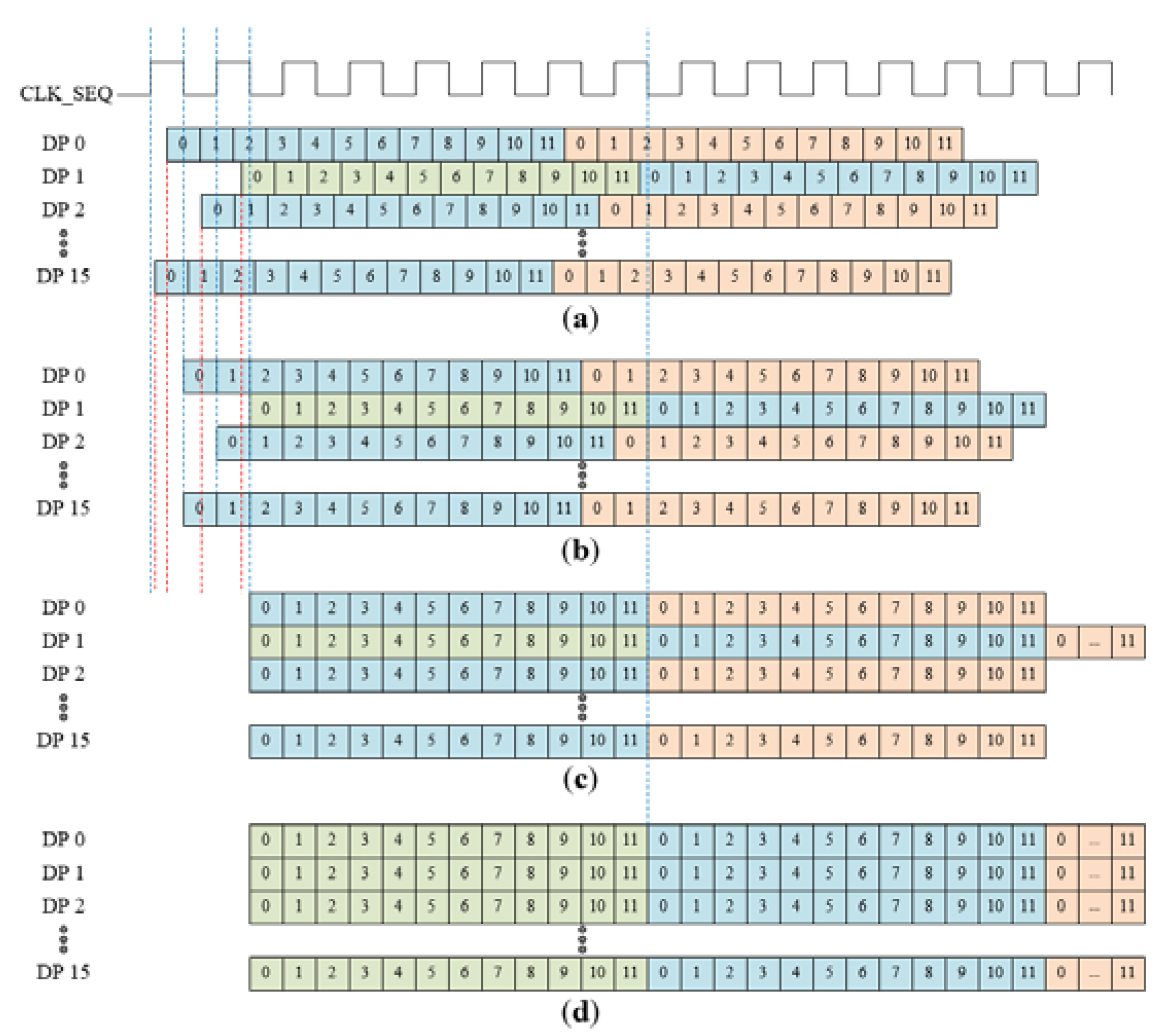

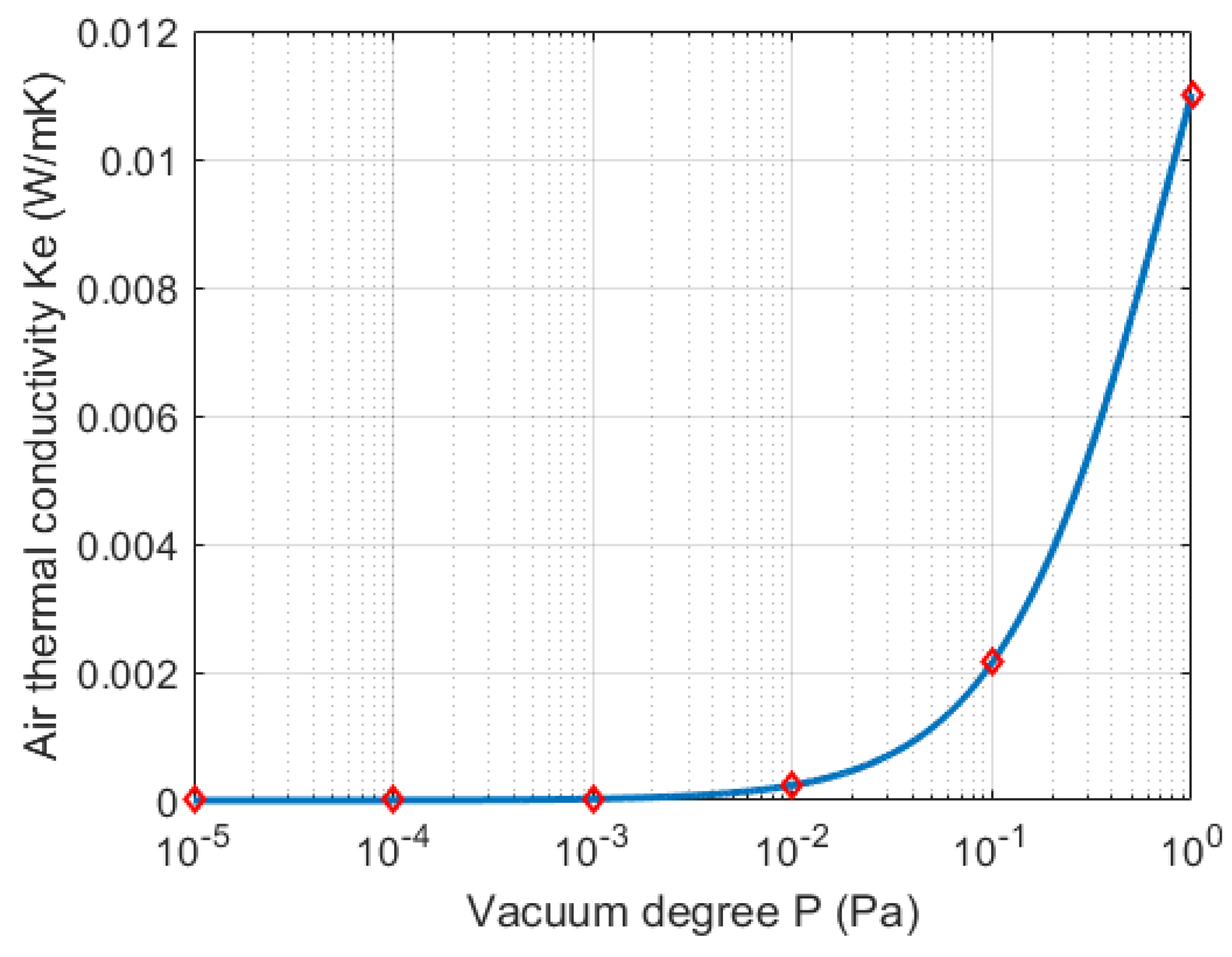
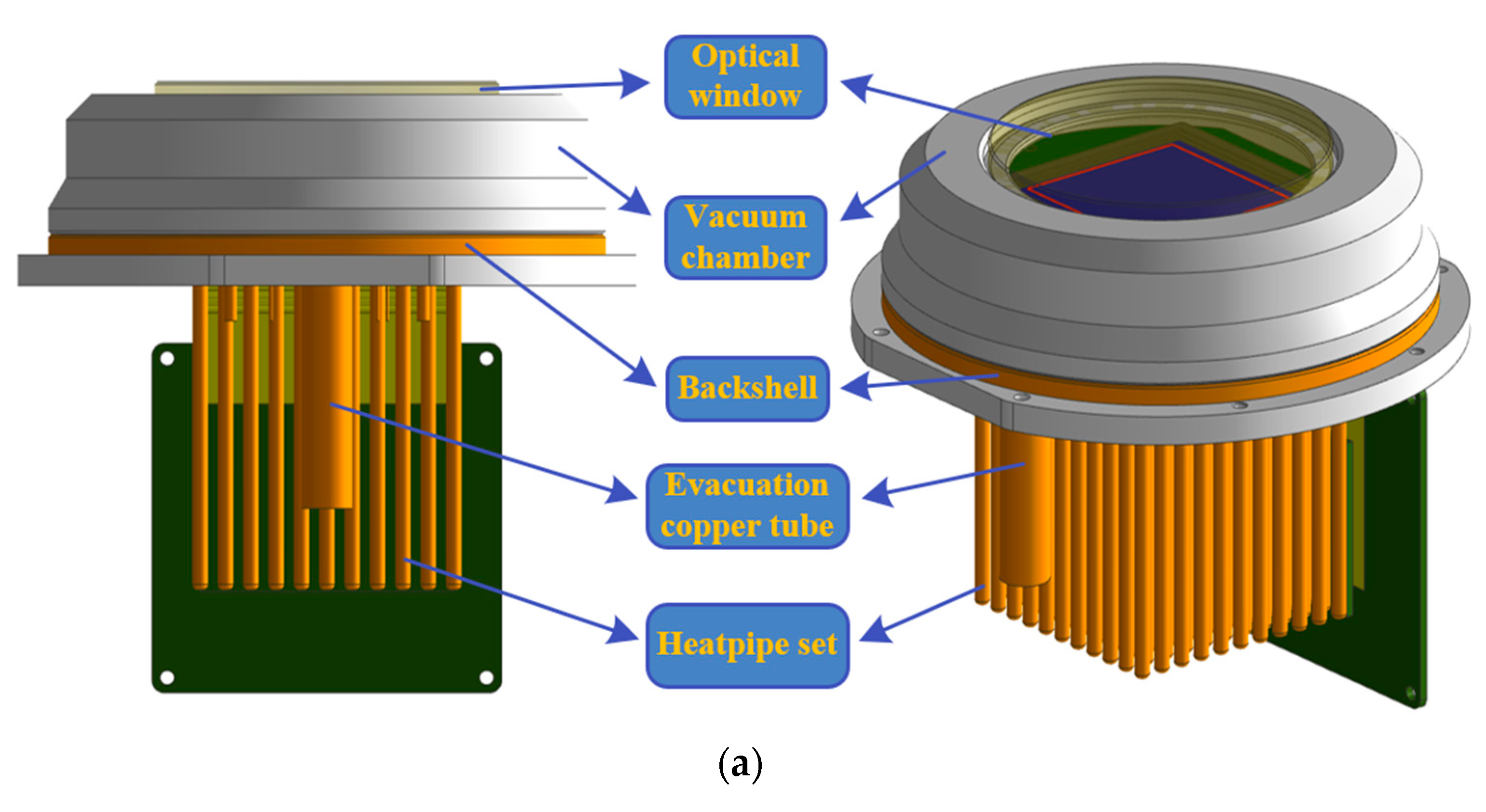
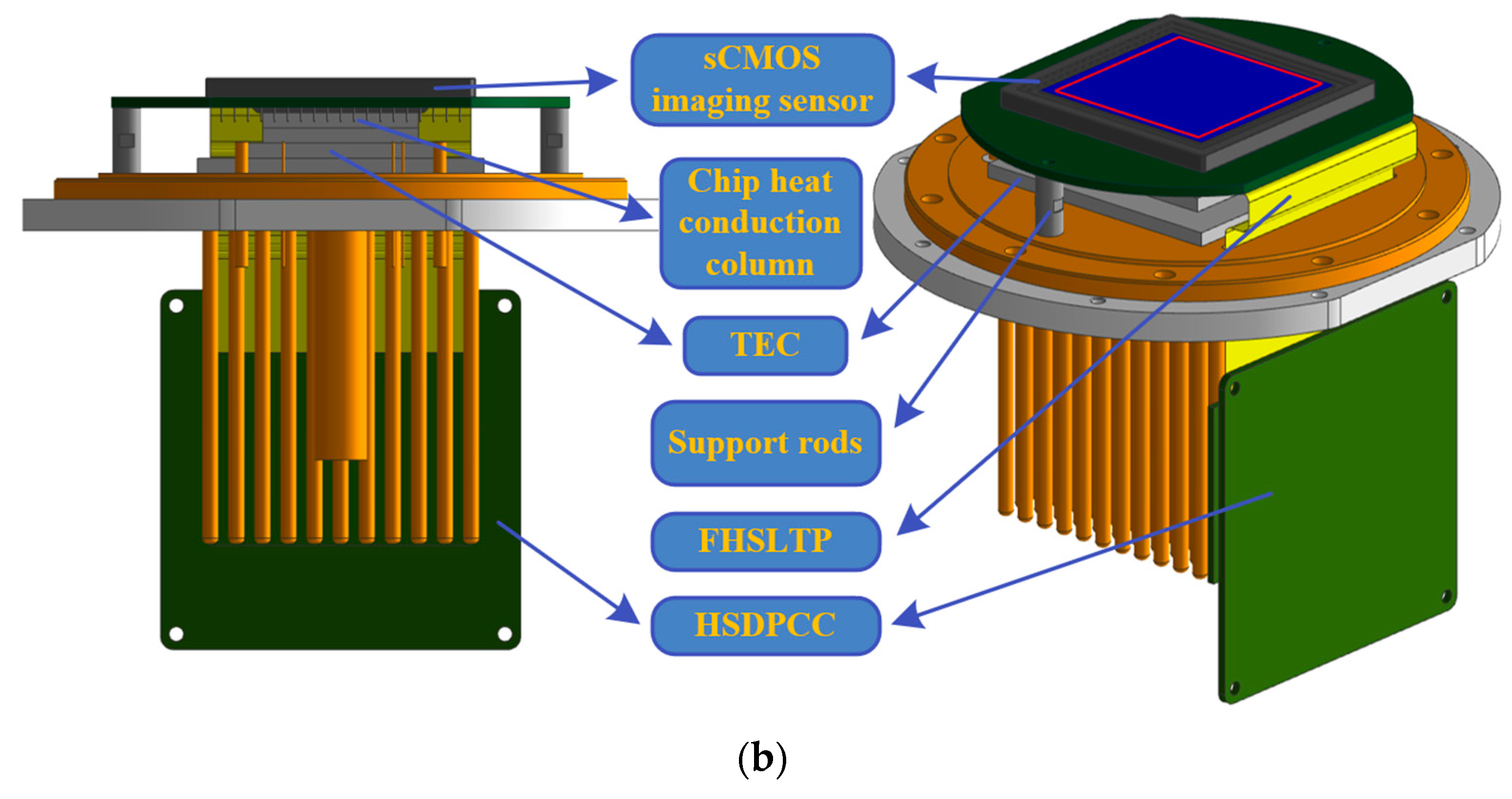
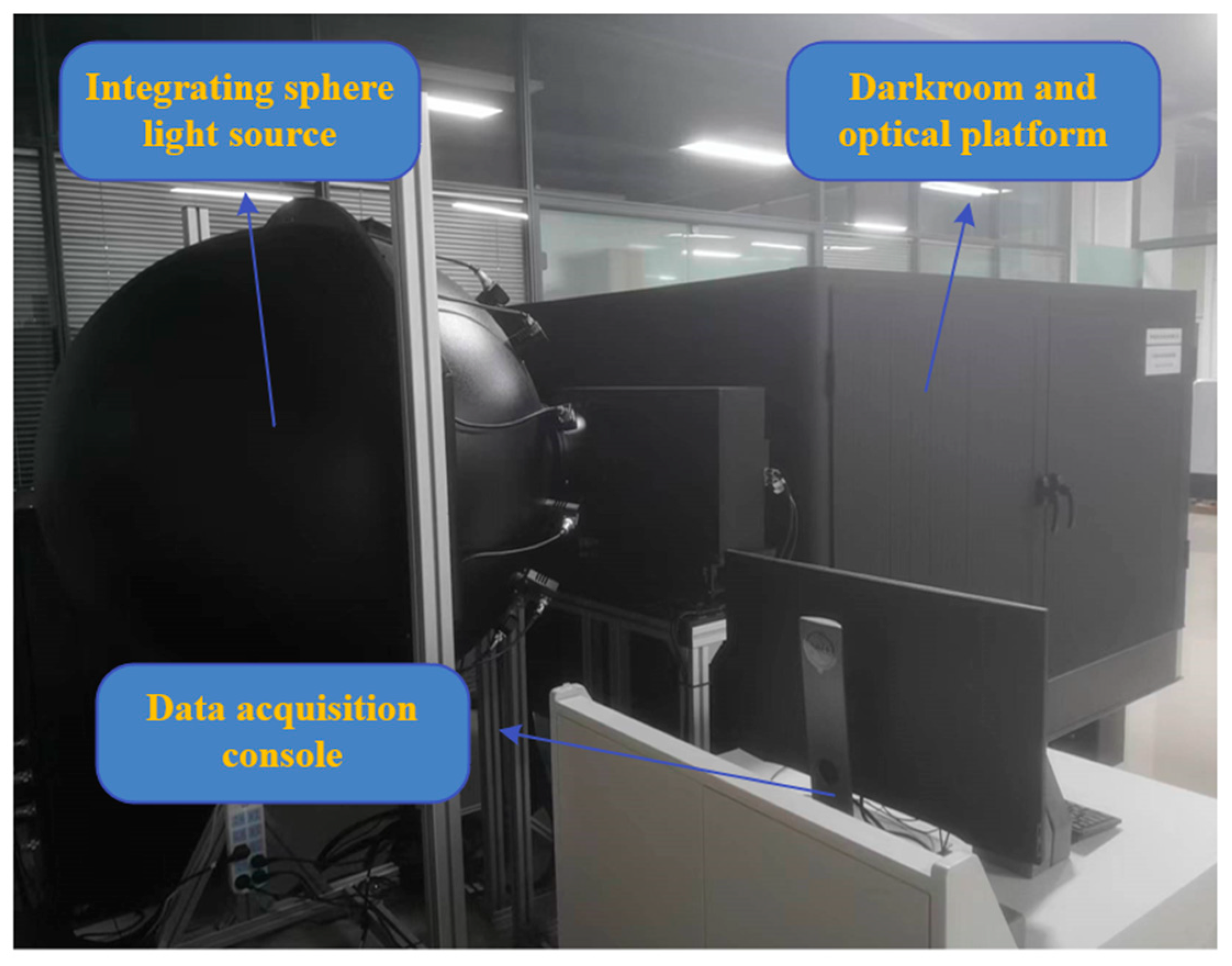
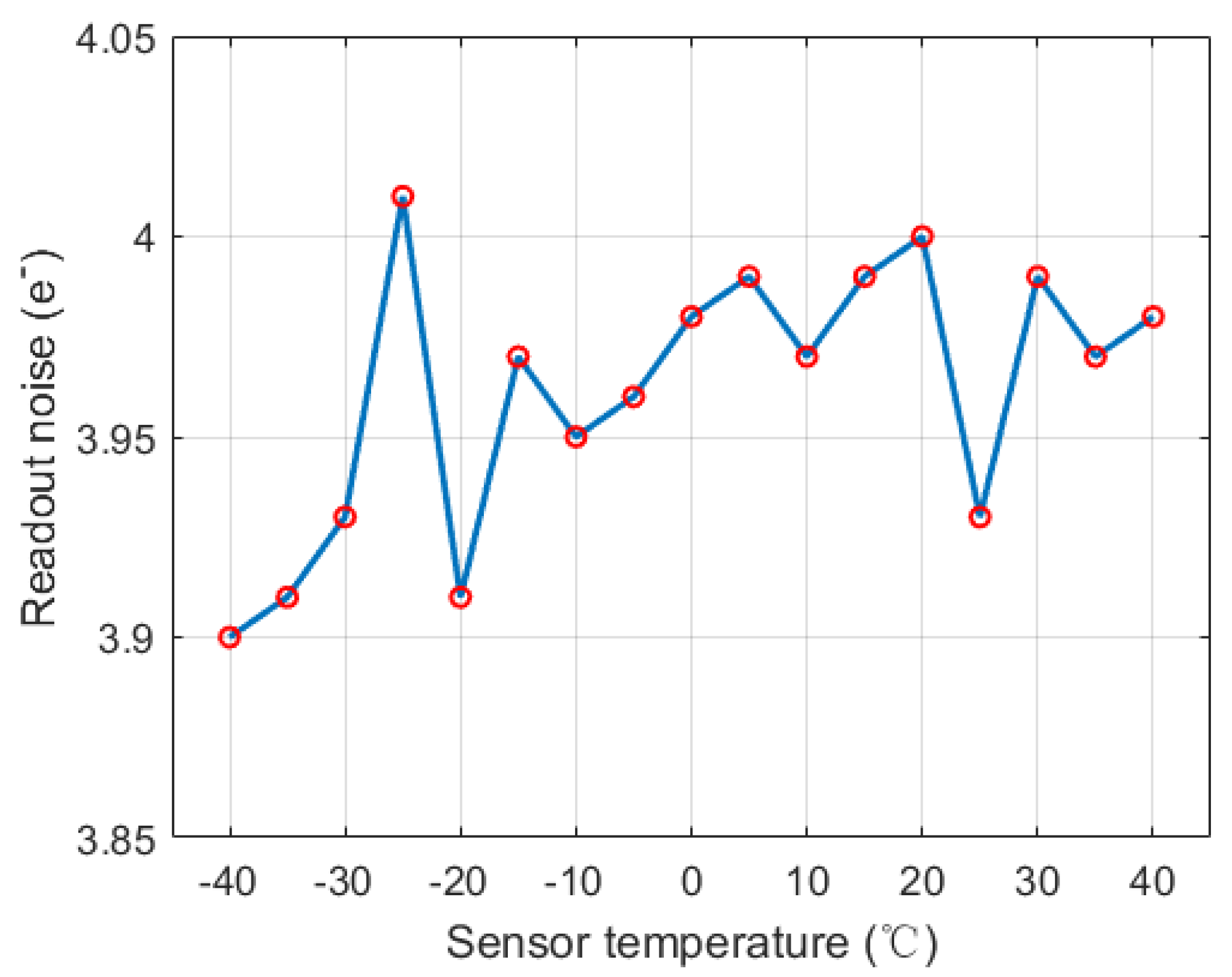

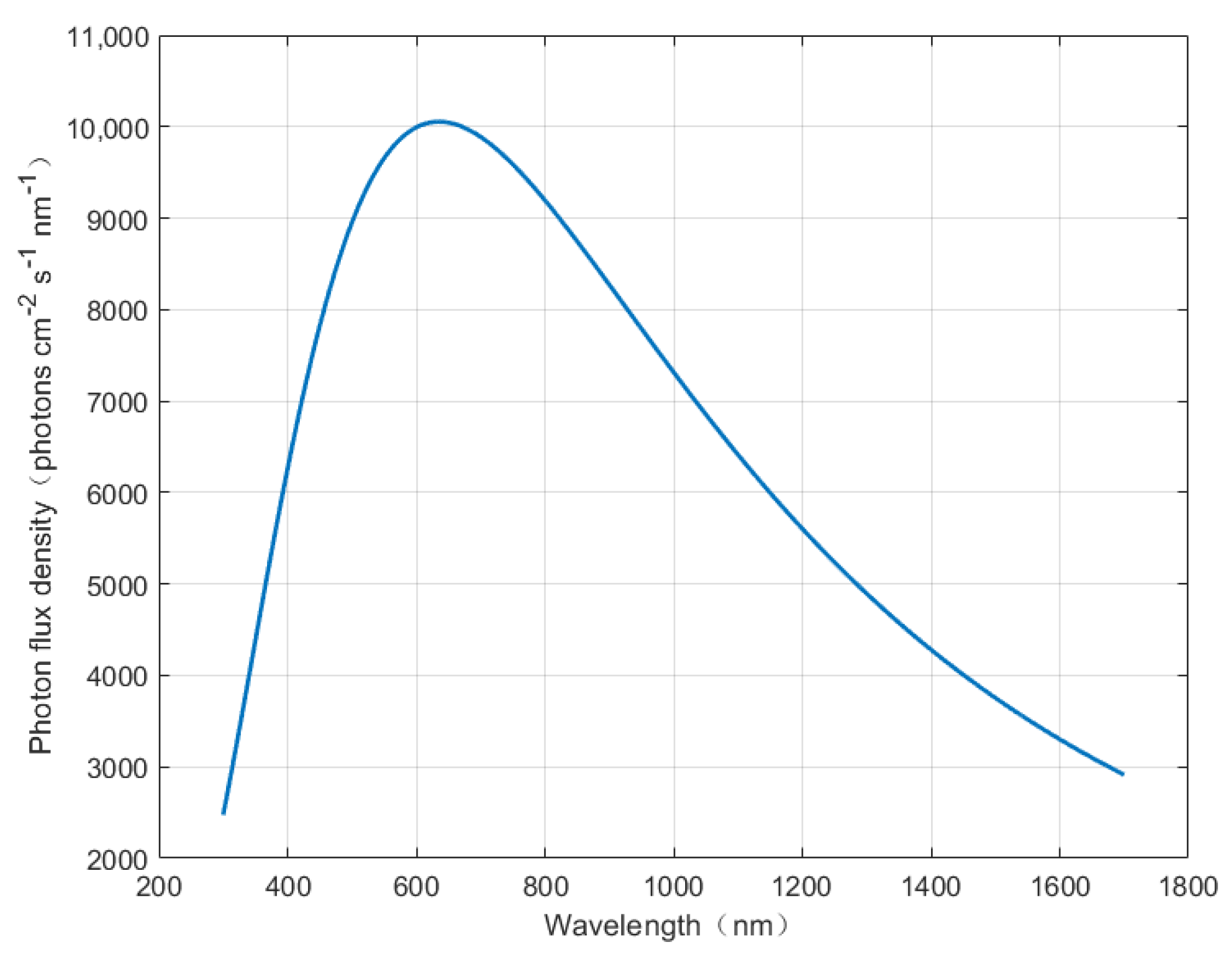

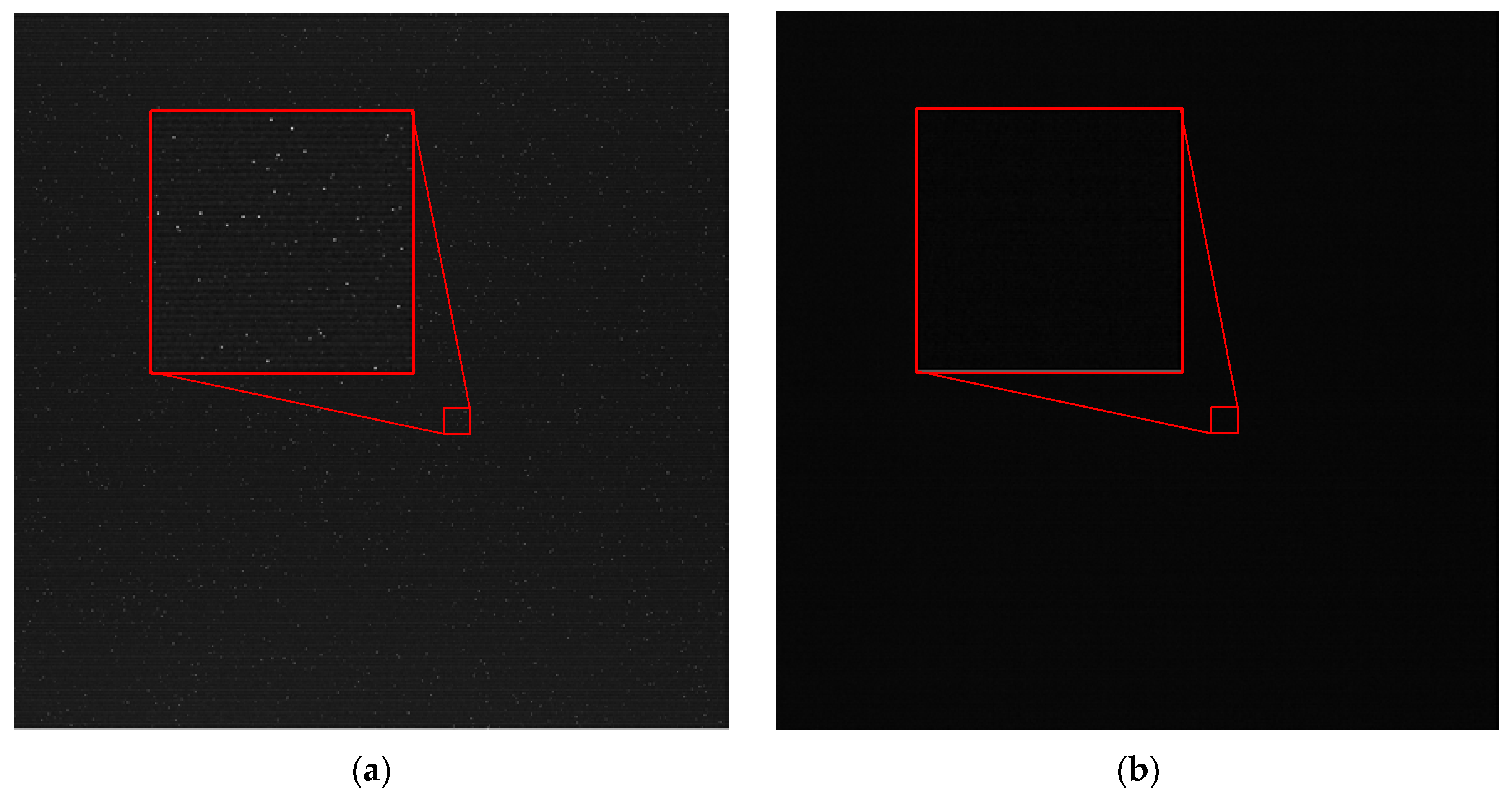

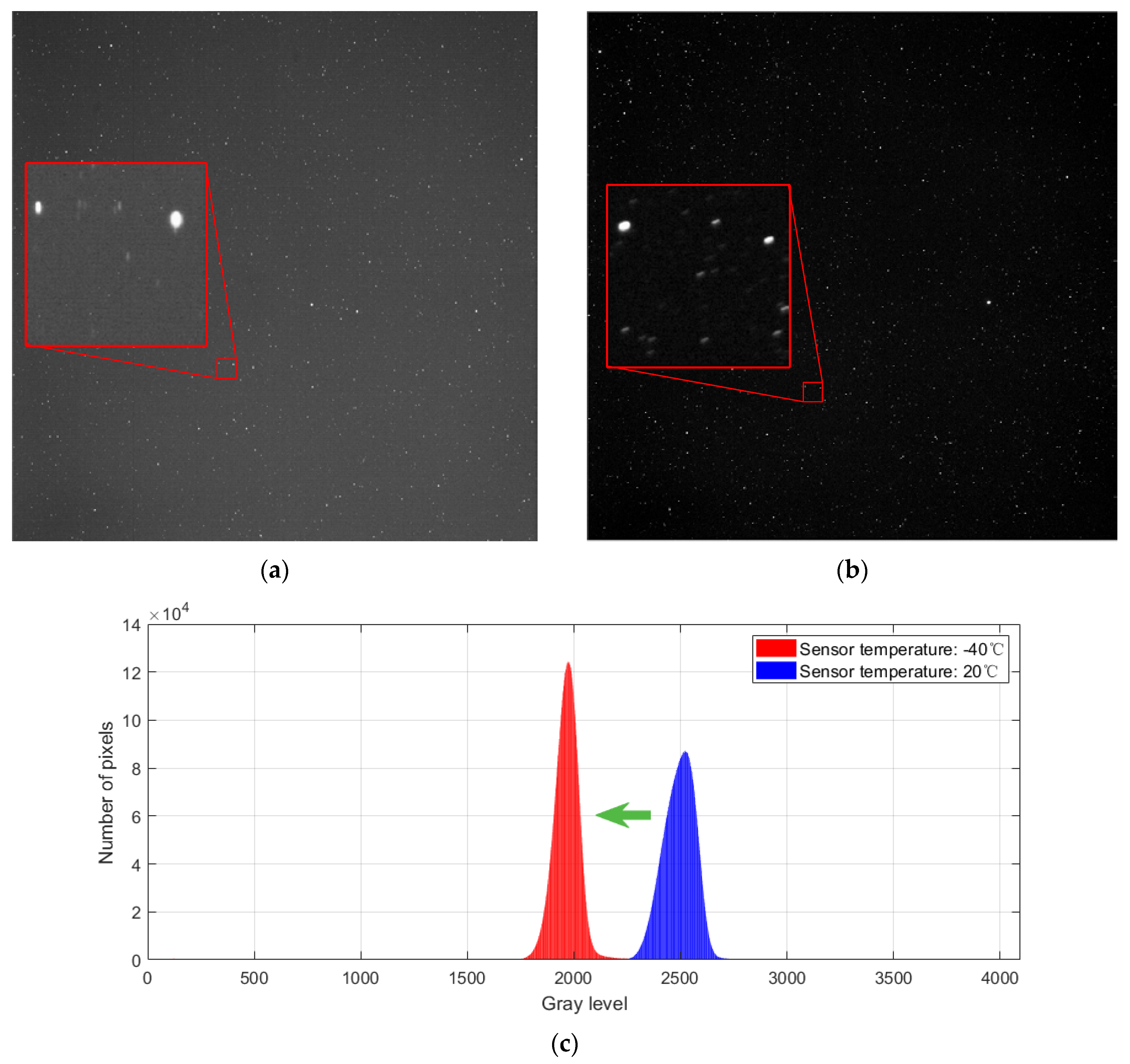

| Parameters | GSENSE4040 |
|---|---|
| Photosensitive area | 36.86 mm × 36.86 mm |
| Pixel size | 9 μm × 9 μm |
| Resolution | 4096 × 4096 |
| Maximum frame rate | 24 fps @ 12-bit HDR |
| Readout noise | 3.7 @ High Gain |
| Dark current | 12.2 /pixel/sec @ 25 °C |
| Dynamic range | 86 dB @ HDR mode |
| Peak QE | 74% @ 600 nm |
| Power consumption | <1.4 W |
| Parameters | Test Results |
|---|---|
| Maximum frame rate | 24 fps @ 12-bit HDR |
| Readout noise | 3.96 @ High Gain |
| Dark current | 0.12 @ −40 °C |
| Dynamic range | 84.49 dB @ HDR Mode |
| Peak QE | >70% @ 580 nm |
| Parameters | HSDVCIS | Andor Zyla 5.5 (2 × 2 Binning) | Andor Neo | Kepler KL6060 |
|---|---|---|---|---|
| Resolution | 4096 × 4096 | 1280 × 1080 | 2560 × 2160 | 6144 × 6144 |
| Pixel size | 9 μm × 9 μm | 6.48 μm × 6.48 μm | 6.5 μm × 6.5 μm | 10 μm × 10 μm |
| Photosensitive area | 36.86 mm × 36.86 mm | 16.6 mm × 14.0 mm | 16.6 mm × 14.0 mm | 61.44 mm × 61.44 mm |
| Maximum frame rate | 24 frames/s | 30 frames/s | 100 frames/s | 5 frames/s |
| Readout noise | 3.96 | 5.1 | 2 | 12 |
| Dynamic range | 84.49 dB | 88 dB | 89 dB | 89 dB |
| Peak QE | >70% | 50−60% (R-band) | 60% | 71% |
| Parameters | Values |
|---|---|
| Effective aperture | 171.4 mm |
| Entrance pupil diameter | 150 mm |
| Field of view | 6.5° × 6.5° |
| Focal length | 215 mm |
| Average transmittance | 74.91% |
| Obscuration ratio | 0 |
Disclaimer/Publisher’s Note: The statements, opinions and data contained in all publications are solely those of the individual author(s) and contributor(s) and not of MDPI and/or the editor(s). MDPI and/or the editor(s) disclaim responsibility for any injury to people or property resulting from any ideas, methods, instructions or products referred to in the content. |
© 2023 by the authors. Licensee MDPI, Basel, Switzerland. This article is an open access article distributed under the terms and conditions of the Creative Commons Attribution (CC BY) license (https://creativecommons.org/licenses/by/4.0/).
Share and Cite
Lu, C.; Liu, C.; Shao, M.; Wu, Z.; Jiang, C.; Cao, J.; Chen, T. Design and Performance Analysis of the Highly Sensitive Deep Vacuum Cooling sCMOS Imaging System for Highly Sensitive Detection of Space Targets. Photonics 2023, 10, 819. https://doi.org/10.3390/photonics10070819
Lu C, Liu C, Shao M, Wu Z, Jiang C, Cao J, Chen T. Design and Performance Analysis of the Highly Sensitive Deep Vacuum Cooling sCMOS Imaging System for Highly Sensitive Detection of Space Targets. Photonics. 2023; 10(7):819. https://doi.org/10.3390/photonics10070819
Chicago/Turabian StyleLu, Changzheng, Changhua Liu, Meng Shao, Zhiyong Wu, Chun Jiang, Jingtai Cao, and Tao Chen. 2023. "Design and Performance Analysis of the Highly Sensitive Deep Vacuum Cooling sCMOS Imaging System for Highly Sensitive Detection of Space Targets" Photonics 10, no. 7: 819. https://doi.org/10.3390/photonics10070819
APA StyleLu, C., Liu, C., Shao, M., Wu, Z., Jiang, C., Cao, J., & Chen, T. (2023). Design and Performance Analysis of the Highly Sensitive Deep Vacuum Cooling sCMOS Imaging System for Highly Sensitive Detection of Space Targets. Photonics, 10(7), 819. https://doi.org/10.3390/photonics10070819





